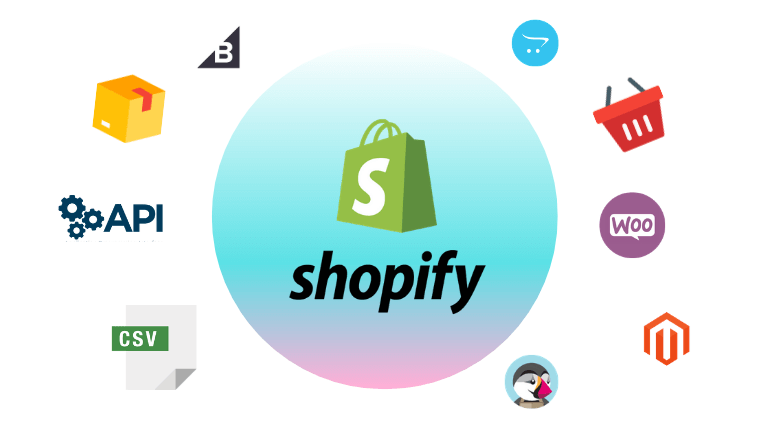Migrating from Magento to Shopify
- by VitaminCommerce
- March 17, 2022
More and more eCommerce stores are moving over to Shopify looking for their new solid store foundations. With Shopify minimal developer support is necessary so merchants can focus on their stores and leave the tech to Shopify. The Magento infrastructure generally requires the support of a development team to apply changes to the site structure and functionalities, eventually increasing the ownership costs in the long term. A shift to Shopify is a priceless investment as you benefit from their brilliant hosting infrastructure and from a variety of add-ons, apps, and exclusive features with simpler functionalities overall.
Why should you migrate from Magento to Shopify?
Magento is a great platform initially developed for mid-large sized companies. The intrinsic structural setup supports custom developments however brands need dev support in the long term. Since Magento 1 evolved to Magento 2 a lot has changed but it remains bound to its legacy. Shopify on the contrary works on a model where new functionalities are offered as a standard to all merchants for basic plans, and additional advantages are available to merchants using Shopify Plus instead. With costly upgrades, Magento remains fundamentally more expensive than Shopify to run for most stores.
The rise of Shopify can be seen via Google Trends, as Shopify has slowly but relentlessly taken over Magento in terms of searches. Magento still retains strong brands internationally, but Shopify is increasingly being favoured by the biggest brands worldwide. We can expect larger companies considering the move over to Shopify soon.
Largest stores worldwide using Shopify vs Magento
Shopify: Tesla, LVMH Moet Hennessy Luis Vuitton, Nestle, PepsiCo, Anheuser-Busch InBev (AB InBev), Kraft Heinz co.
Magento: Moschino, Christian Louboutin, Olympus, Coca Cola Store, Jaguar, Land Rover
Migrating from Magento to Shopify can be a daunting process, but we’ve listed it out in easy steps for you. After all, we’ve done hundreds of migrations and if you want to save yourself the time contact us to help.
1. Set up Shopify
Which one do you need? Well, that depends on where your brand is.
- Basic Shopify ($29/month)
- Shopify ($79/month)
- Advanced Shopify ($299/month)
- Shopify Plus (starting at $2000/month)
The plan/subscription you choose will generally be based on the size and nature of your business, as some customised Magento platforms will need to be migrated to bespoke automations. For more details on Shopify plans and pricing, see here.

2. Create a backup
This is the important rule of any migration. Always create a backup. With a migration, anything can happen. So to avoid tears, stress and data loss a backup is the most effective solution. For this step, get the backup of your store, using the Magento Admin sidebar, specifically ‘System’ >‘Tools’ >‘Backups’.the Admin sidebar, then ‘System’ >‘Tools’ >‘Backups’.
3. Download a migration App and export
Take a trip to the Shopify App Store and you’ll find a number of Magento to Shopify migration apps. There are even a few with great reviews that could really help with your data transfer.
Before initiating the migration, determining exactly what data is relevant and necessary to carry over is really important. If you are migrating from a perfectly clean Magento site, you’ll get better results of course. Once that’s all finished, all your data will be on a spreadsheet. This spreadsheet can be clearly understood by Shopify’s software, therefore, easing the migration process. But you may still need to handle some manual cleanup after running an app. Apps also can’t help with anything coding-related, they are mostly used to export and import data.
After the completion of data import, it’s also important to check whether everything in the new store works properly. So running some test orders through the checkout will ensure client data is organised and displayed correctly on a live store.

4. Design your new Shopify store
Now that your store has been migrated from Magento to Shopify and all your data fields have been checked it is time for the final step- designing your new Shopify store. An advantage of using Shopify over Magento is the better control over aesthetics, with plenty of themes to choose from which can be customised to match the website’s look and feel to your brand.
Merchants can either use a theme (ideally a 2.0 one that gives merchants higher flexibility to manage it) or you can create a bespoke front-end store and integrate all ERP, PIM, CRM, fulfilments and accounting software you desire.
Shopify has inbuilt themes prepared for you to utilise instantly. Some of the themes are free, while others are paid. The best part is, you need don’t need to be a coding expert.
Why switching from Magento to Shopify is a good idea
While Magento can do some great stuff, Shopify is the better choice for raising your brand with the integral difference being the cost of set-up and ownership.

Essentially, the Shopify platform provides better control over design aesthetics and offers great opportunities for international expansion with the introduction of Shopify Markets. In a nutshell, Shopify is a customisable, secure and supported solution to scale your brand and your eCommerce store further. Plus merchants can expect future updates to be rolled out to their stores for free or included in the price they’re already paying. This is great value when compared with Magento as every new and future functionality will need to be built in from a development team instead. Switching means you’ll be able to focus on your brand and leave a lot of the behind the scenes tech to Shopify.
Moving from Magento to Shopify Plus is one of the most common re-platforming routes in eCommerce. If you need guidance with the process, contact us & we can help you on your journey.
Stay up to date





